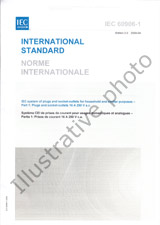We need your consent to use the individual data so that you can see information about your interests, among other things. Click "OK" to give your consent.

IEC 62226-3-1-ed.1.0
Exposure to electric or magnetic fields in the low and intermediate frequency range - Methods for calculating the current density and internal electric field induced in the human body - Part 3-1: Exposure to electric fields - Analytical and 2D numerical models
STANDARD published on 23.5.2007
The information about the standard:
Designation standards: IEC 62226-3-1-ed.1.0
Publication date standards: 23.5.2007
SKU: NS-414310
The number of pages: 109
Approximate weight : 358 g (0.79 lbs)
Country: International technical standard
Category: Technical standards IEC
The category - similar standards:
Annotation of standard text IEC 62226-3-1-ed.1.0 :
Applies to the frequency range for which exposure limits are based on the induction of voltages or currents in the human body when exposed to electric fields. Defines in detail the coupling factor K - introduced by the IEC 62226 series to enable exposure assessment for complex exposure situations, such as non-uniform magnetic field or perturbed electric field - for the case of simple models of the human body, exposed to uniform electric fields. The coupling factor K has different physical interpretations depending on whether it relates to electric or magnetic field exposure. It is the so called "shape factor for electric field". This part of IEC 62226 can be used when the electric field can be considered to be uniform, for frequencies up to at least 100 kHz. This situation of exposure to a "uniform" electric field is mostly found in the vicinity of high voltage overhead power systems. For this reason, illustrations given in this part are given for power frequencies (50 Hz and 60 Hz). Sapplique a la gamme de frequences pour laquelle les limites dexposition sont fondees sur des tensions ou des courants induits dans le corps humain, quand il est expose aux champs electriques. Definit le facteur de forme K - introduit par la serie CEI 62226 pour permettre levaluation de lexposition dans des situations dexpositions complexes, telles quun champ magnetique non uniforme ou un champ electrique perturbe - pour les cas de modeles simples de corps humain, expose a des champs electriques uniformes. Le facteur de couplage K peut avoir differentes interpretations physiques selon quil se refere a lexposition a un champ electrique ou magnetique. Il est aussi appele "facteur de couplage pour champ electrique". La presente partie de la CEI 62226 peut etre utilisee quand le champ electrique peut etre considere comme uniforme, pour des frequences jusqua au moins 100 kHz. Cette situation dexposition a un champ electrique "uniforme" se trouve principalement a proximite des systemes aeriens dalimentation electrique a haute tension. Pour cette raison, les illustrations donnees dans cette section sont aux frequences industrielles (50 Hz et 60 Hz).
These changes apply to this standard:
Amendment 1 - Exposure to electric or magnetic fields in the low and intermediate frequency range - Methods for calculating the current density and internal electric field induced in the human body - Part 3-1: Exposure to electric fields - Analytical and 2D numerical models
(Amendement 1 - Exposition aux champs electriques ou magnetiques a basse et moyenne frequence - Methodes de calcul des densites de courant induit et des champs electriques induits dans le corps humain - Partie 3-1: Exposition a des champs electriques - Modeles analytiques et numeriques 2D)
Change published on 7.10.2016
Selected format:Show all technical information.
We recommend:
Technical standards updating
Do you want to make sure you use only the valid technical standards?
We can offer you a solution which will provide you a monthly overview concerning the updating of standards which you use.
Would you like to know more? Look at this page.



 Cookies
Cookies
